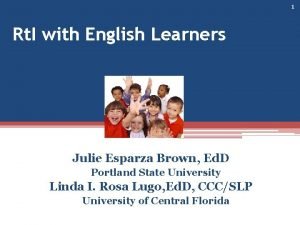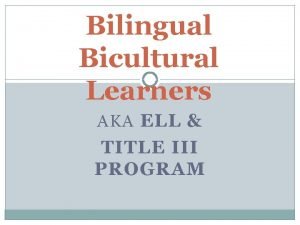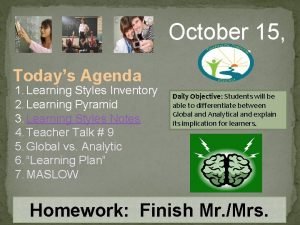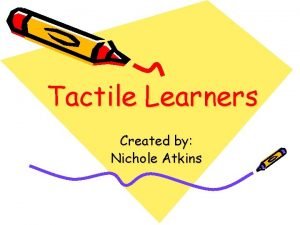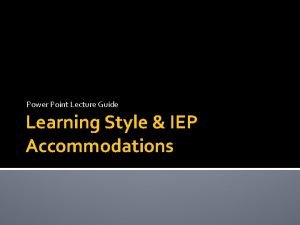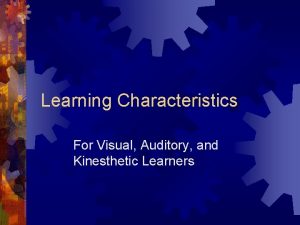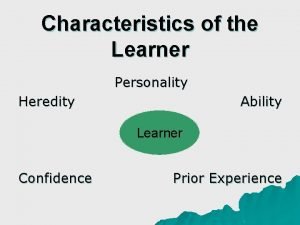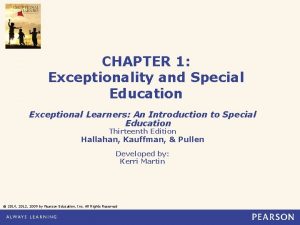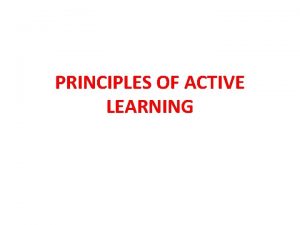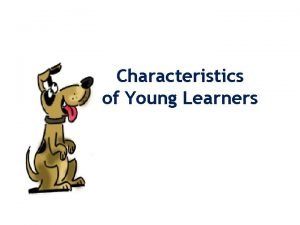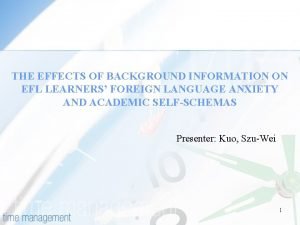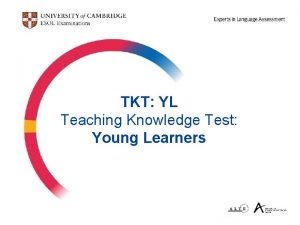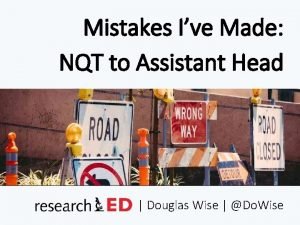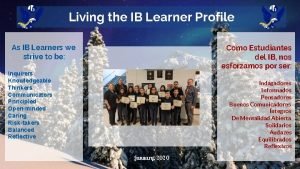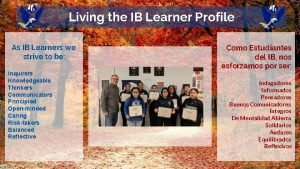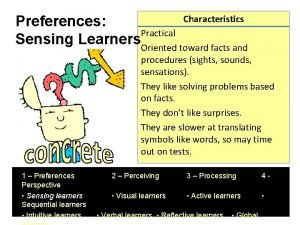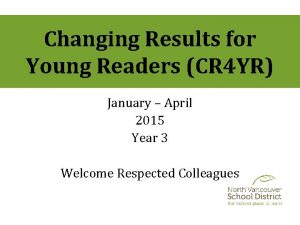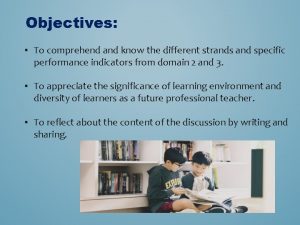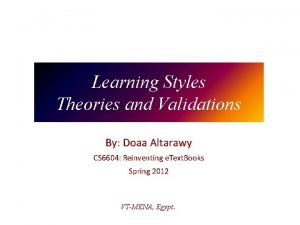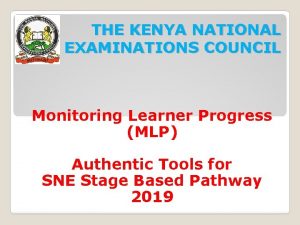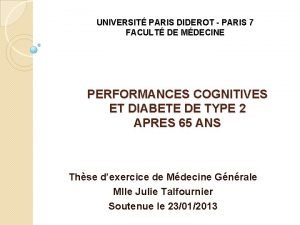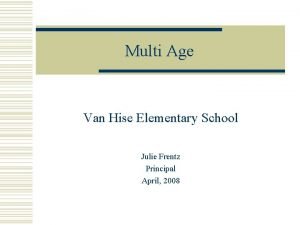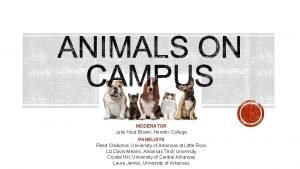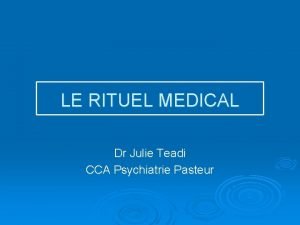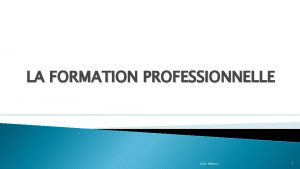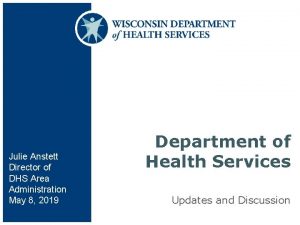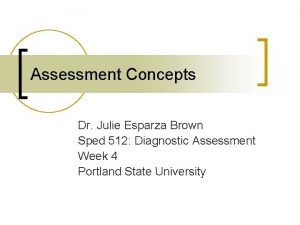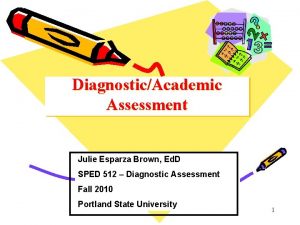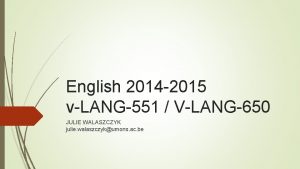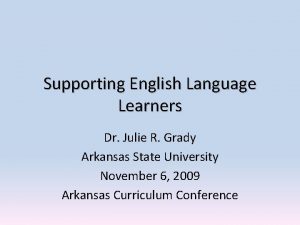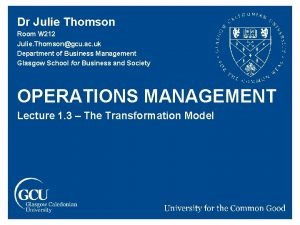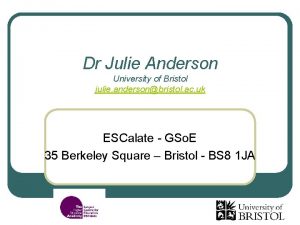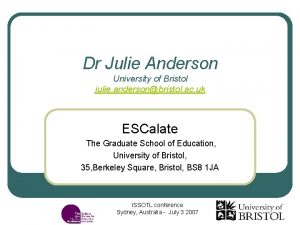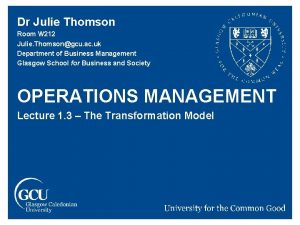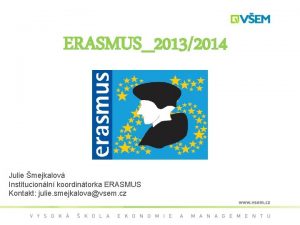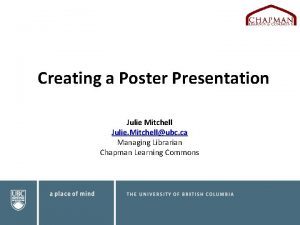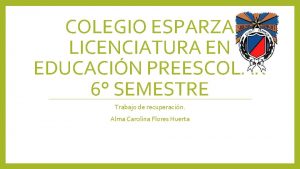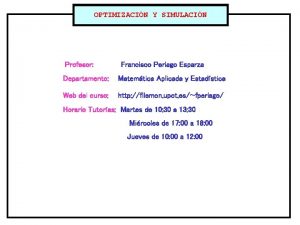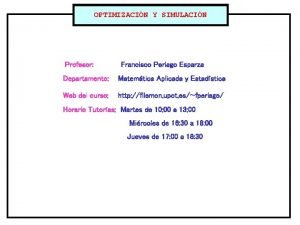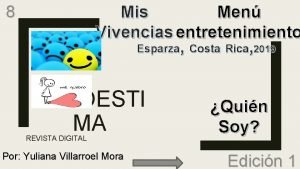1 Rt I with English Learners Julie Esparza





























































- Slides: 61

1 Rt. I with English Learners Julie Esparza Brown, Ed. D Portland State University Linda I. Rosa Lugo, Ed. D, CCC/SLP University of Central Florida

2 Guiding Questions What is RTI? What does an RTI process for ELs look like? How do cultural, linguistic, and experiential differences impact instruction and intervention? How does the RTI process help to determine difference vs. disability? Is a comprehensive special education evaluation still necessary in this model? What competencies do education professionals need to support EL students through the RTI process?

3 RTI Defined “Rigorous implementation of RTI includes a combination of high quality, culturally and linguistically responsive instruction; assessment; and evidence-based intervention. Comprehensive RTI implementation will contribute to more meaningful identification of learning and behavioral problems, improve instructional quality, provide all students with the best opportunities to succeed in school, and assist with the identification of learning disabilities and other disabilities. ” National Center on Response to Intervention

4 Improving Learning Outcomes • One major goal of RTI is to improve the learning outcomes for all students and reduce the number of students inappropriately identified as having a specific learning disability by intervening early in their educational process. (Individuals with Disabilities Education Improvement Act, 2004, Part B, Sec 614 (b)(6)(b)). • RTI is conceptualized as a tiered model of increasingly intense instructional support to match students’ needs. • The most common models currently are in reading.

niz ers e us hic org a dg rap an ua ls vis se for ies gic ate pra ctic e; U Core plus strategic evidence-based intervention; “double dose”; must include oracy component (15% of all students) Core curriculum & instruction for ALL students: school-wide reading, behavior, math and/or writing, includes sheltered and linguistically appropriate instruction and culturally relevant teaching (80% of all students disaggregated by subgroups) For ELS: Core includes English as a Second Language Services Str tive na of nit n; tio uc str pp ort u t in Pre-teach critical vocabulary; PLUSS teaching for transfer nd ea ag gu lan &o lici ling xp &e mo de tic ng ua ge intensive evidence-based Intervention, includes oracy component (5% of all students) ma La ste Sy An RTI Model for English Learners

6 Key Features of an RTI Model • Evidence-based core curriculum; goal is for all students to reach grade-level benchmarks. Assumes effective instruction in core for all students. • Universal screening in foundational components of reading (or math) to determine who is at-risk for reading difficulties. • Intervening early in reading (or math) with increasingly intense evidence-based interventions taught with fidelity. • Use screening and progress monitoring data to determine students’ responsiveness to instruction/intervention and progress towards gradelevel benchmarks and standards

7 Concerns When Working with ELs RTI Feature • Evidence-based core curriculum and instruction for all students to meet grade-level standards. • Universal screening in foundational components of reading (or math) to determine who is at-risk for reading difficulties. Concern for ELs • Limited core curriculum that adjusts instruction to meet EL students’ language levels; educators often lack basic competencies in working with ELs • Must determine the reliability and validity of screening tools used with ELs

8 Concerns When Working with ELs RTI Feature • Intervening early in reading (or math) with increasingly intense evidence-based interventions taught with fidelity. • Use screening and progress monitoring data to determine students’ responsiveness to instruction/intervention and progress towards grade-level benchmarks and standards Concern for ELs • Limited intervention programs that have been researched on English Learners (e. g. , What Works Clearinghouse). • Assessment tools must be reliable and valid for use with ELs, ELs cannot be expected to meet grade-level benchmarks within the time frame as English-only students

9 What Do We Need to Know About English Learners?

10 English Learners Defined • The National Center for Education Statistics (NCES, 2011) reports the number of English Learners (ELs) in public schools rose from 4. 7 to 11. 2 million between 1980 and 2009 (a 21% increase). • ELs are a diverse group representing more than 425 languages, yet what defines them is their need for specialized language support to fully participate in English-only educational programs (Goldenberg, 2008). • Of all ELs, 80 percent are Spanish-speakers (Goldenberg, 2008).

11 English Learners Defined • The majority of them are U. S. born and have received all of their education in American schools. • ELs achieve oral fluency in everyday language but lag in measures of academic success and tasks requiring academic language proficiency. • The term “EL” student does NOT include fluent bilingual students.

12 Are ALL Educators Prepared to Teach ELs? How About You? • In 2002, the National Center for Educational Statistics found that among 41% of U. S. teachers with EL students only 12. 5% had received 8 or more hours of PD in instruction of ELLs.

13 Three Categories of ELs who Experience Academic Difficulties 1. Those with ineffective instructional programs and environments ▫ Instruction is not appropriately adjusted to student’s language needs 2. Difficulties due to life circumstances ▫ Interrupted schooling, limited formal education, mobility, limited access to standard English, etc. 3. EL students with intrinsic and true disorders

14 Let’s Talk About Language

15 BICS = Basic Interpersonal Communication Skills CALP = Cognitive Academic Language Proficiency (Cummins, 2000)

16 Basic Interpersonal Communication Skills (BICS) • Language proficiency needed in order to function in everyday interpersonal contexts and carry on a conversation in familiar face-to-face situations: ▫ ▫ greetings words of courtesy numbers/calculations playground conversation

17 Cognitive Academic Language Proficiency (CALP) • Level of language needed to function in decontextualized, academic settings where students are required to understand linguistically and conceptually demanding texts in content areas and to use this language in an accurate and coherent way in their own writing. ▫ ▫ Language required for: solving mathematical word problems reading academic texts taking tests • To develop academic language proficiency requires extensive reading of texts to expand vocabulary knowledge and demystify language structures. • Typically attained between five to seven years in host country but up to eleven years when native language is not used for instruction (Thomas & Collier, 2002).

18 Language Proficiency • a person's competence in processing (through listening and reading) and using (through speaking and writing) language (WIDA ELD Standards, 2012) • Language proficiency alone will not be a determinant of a child’s ability to learn in L 2. Previous schooling, experiences, and what they have learned in L 1 must also be considered.

19 Primary Language • Language that the student learns first and uses most frequently in the early stages of language development. • Language of the home and used to make meaningful communicative relationships with their family. • Primary language best determined through home language surveys and carefully conducted parent interviews. • Parents must be encouraged to use and develop children's home language.

20 Dominant Language • The language that the student speaks most fluently and chooses to speak when given a choice. • The dominant language can be situational in nature. For example, a child schooled only in English will ultimately become dominant in English academic language. • However, the primary language may remain dominant in other social situations such as church or community events.

21 Proficiency Levels of ELs I. & II. Pre-Production & Beginning Students Can: “I have little or no English proficiency. ” Beginner students are those with little or no English proficiency. The English sound system is new to them, and they comprehend little of what is said in English. ! They may go through a "silent period" where they do not attempt to speak in English. ! However, beginner students may quickly connect the concepts they know in their primary language to the new English language environment, and they can participate in the classroom by doing the activities listed here. Beginners may demonstrate various levels of oral and literacy skills in their primary language. Adapted from IDRA, Intercultural Development Research Association © 2000 Point ! Draw ! Match ! Select ! Circle ! State Choose Act Out ! Label ! Name ! List ! Northwest Regional Education Service District

22 Proficiency Levels of ELs III. Intermediate Students Can: ! Recall “I have good oral skills in English, but minimal reading and composition skills in English. ” ! Retell ! Define ! Describe ! Compare ! Contrast ! Summarize ! Restate Intermediate level students have good oral skills in English but have minimal reading and composition skills in English. They may be able to carry on social conversations, however understanding academic language and reading and writing at grade-level in English is difficult. Some intermediate students may be literate at or above grade-level in their primary language. Literate students quickly transfer reading and writing skills into English and are able to perform the activities listed here. Adapted from IDRA, Intercultural Development Research Association © 2000 Northwest Regional Education Service District

23 Proficiency Levels of ELs IV. & V. Early Advanced and Advanced Students Can: ! Analyze ! Create “I am fluent in oral English ! Defend and have some reading and ! Debate writing skills, but need help ! Evaluate to pass tests. ” ! Justify ! Support Advanced students are those who are nearly proficient in English. ! Explain They understand speak English fluently but have difficulty reading and writing in English. Advanced students have difficulty taking standardized and norm-referenced tests because of the language required to explain thinking. Some advanced students may by fully literate in their home language (L 1) while others may have only limited literacy skills in their L 1. In order for advanced students to become proficient in English, they need experiences that involve the following skills listed here. Adapted from IDRA, Intercultural Development Research Association © 2000 Northwest Regional Education Service District

24 Second Language Acquisition Strategies and Activities All students learn when the information is comprehensible. ELs require second language acquisition strategies and activities that make the language and information I. & II. Pre- III. Intermediate comprehensible. Production/ Beginning IV. & V. Early Advanced/ Advanced v All levels of ELs benefit from: v. Modeling & explicit instruction v. Frequent opportunities to practice using language v. Visual aids & Graphic Organizers v. Cooperative grouping activities v. Manipulative and hands-on activities v. Vocabulary Strategies Adapted from IDRA, Intercultural Development Research Association © 2000 Northwest Regional Education Service District

25

26 “Young children who have not had sufficient opportunities to develop cognitive skills in their first language before learning a second language are at greater risk for academic delays than their peers who have had opportunities to develop and use their first language” (cited in Kohnert, et al, Cummins, 1984).

27 Determining Need for Support

28 Screening and Progress Monitoring in a Problem Solving Framework 1. Define the problem (screening) 2. Analyze 3. Develop a Plan 4. Evaluate (progress monitoring)

29 Define the Problem: Unique Considerations for Screening ELs (Brown & Sanford, 2011) 1. Use tools with demonstrated reliability and validity to identify and monitor students’ needs for instructional support in reading in both L 1 and L 2. 2. Assess students’ language proficiency in L 1 and L 2 to provide an appropriate context regarding evaluation of current levels of performance. 3. Plan instruction based on what you know about the student’s performance and literacy experiences in L 1 and L 2 and teach for transfer if needed.

30 What Are the Unique Considerations for Screening and Progress Monitoring ELs? • Reliability: does the assessment produce similar scores across conditions and situations? • Reliability is not a particular problem if the tool has good psychometric properties. • Validity: does the test measure what you want to assess? • Validity may be a problem because assessment results could be influenced by students’ language, cultural and experiential backgrounds. • There is evidence for the validity of using CBMs with ELs (Deno, 2005; Wiley & Deno, 2005)

31 Gather Formative Assessment Data • Screening • Universal screening is conducted on a regular basis (2 – 3 times per year) for all students • Screening assessments are brief, individual, and will identify which students are struggling with core concepts

32 Progress Monitoring • Progress Monitoring • Occurs more frequently than screening assessments • Tools must be valid and reliable • Screening and progress monitoring tools may be the same instrument.

33 Commonly Used Assessments for ELs: Screening and Progress Monitoring • DIBELS/IDEL ▫ General outcome measure ▫ Benchmark and progress monitoring system based on student continuous assessment ▫ Designed to determine if a student is learning and making progress toward the long term reading goal ▫ Between 2 – 5 minutes to administer per indicator ▫ IDEL is the Spanish version • Aimsweb/MIDE ▫ General outcome measure ▫ Benchmark and progress monitoring system based on student continuous assessment ▫ Designed to determine if a student is learning and making progress toward the long term reading goal ▫ Between 2 – 5 minutes to administer per indicator ▫ MIDE is the Spanish version

34 Commonly Used Assessments for ELs: Screening and Progress Monitoring • CORE ▫ Assessment of comprehension skills related to reading. ▫ Makes classroom comparisons. ▫ Some assessments in Spanish but not all. • STAR ▫ Computerized benchmark and progress monitoring. ▫ Available in English only.

Commonly Used Assessments for ELs: Diagnostic Assessment 35 • DRA/EDL • Designed to measure the level in which the students can read “independently”. • Considered “benchmark” assessments that help teachers measure student progress and are collected at the beginning, middle and/or end of the year. • Approximately 30 minutes to 1 hour per student to administer.

36 Evaluate: Unique Considerations for Progress Monitoring ELs (Brown & Sanford, 2011) 1. Monitor student’s progress in all languages of instruction 2. Set rigorous goals that support students to meet gradelevel standards. You may need to set shorter term goals to meet long term goals since ELs will NOT progress at the same rate as English only students. 3. Evaluate growth frequently, increasing intensity of instruction (or change interventions) when growth is less than expected 4. Evaluate growth of “true peers” (peers with similar background in language, experience, culture, birth country, education in L 1 & L 2) to determine whether instruction is generally effective for students with similar linguistic and educational experiences 36

37 Tiered Support • Depending on a student’s need, Tier 1, 2 or 3 interventions are provided. • Tier 1 ▫ Intervention in core materials, small groups (5 -7) in general education ▫ Provided by teacher or other educator ▫ Attention must be given to student’s language proficiency level (in the language of instruction), and cultural and experiential background

38 Tiered Support • Tier 2 ▫ A “double dose” of core. May be different materials but goal is to meet grade-level standards. ▫ Small group instruction (3 -5) ▫ Instruction must continue to be adapted to student’s language proficiency level and cultural and experiential background ▫ An additional oracy (listening & speaking) component should be included to ensure ELs understand the vocabulary and language structures used within the intervention ▫ Intervention must match instructional language of classroom

39 Tiered Support • Tier 3 ▫ Different curriculum is used as student is not at grade level ▫ Small group instruction (1 -3) ▫ Instruction must continue to be adapted to student’s language proficiency level and cultural and experiential background ▫ An additional oracy (listening & speaking) component should be included to ensure ELs understand the vocabulary and language structures used within the intervention ▫ If an EL student is considered for special education, a comprehensive evaluation should be conducted.

40 Instruction and Intervention for ELs: PLUSS MODEL

41 Explicit Instruction • Research indicates that ELLs need explicit and systematic core reading instruction in reading instruction (i. e. , phonemic awareness, phonics, fluency with connected text, vocabulary, and comprehension strategy instruction) (Fien, Smith, Baker, Chaparro, Baker & Preciado, 2010; Gersten, Baker, Shanahan, Linan-Thompson, Collins & Scarcella, 2007). • Els need additional instructional time for English language development, with deliberate and focused instruction on English language proficiency that is coordinated and aligned with reading instruction (Linan-Thompson & Vaughn, 2007).

42 The Need to Enhance Core Instruction and Interventions • Most core and intervention programs do not provide enough explicit, scaffolded instruction or practice opportunities for ELLs (Gersten, 1999). • Explicit teacher modeling is frequently absent, and, if present, the models are vague and inconsistent (Baker & Baker, 2008). • There are limited modeling and practice opportunities needed for deep understanding. • Vague directions may confuse EL students. • However, core programs can be enhanced for ELLs by focusing on variables related to explicit and systematic instruction (Linan-Thompson, Bryant, Dickson, & Kouzekanani, 2005) and language demands.

43

44

45 Do Skills Learned in L 1 Transfer to L 2? • YES!!! • Cross-linguistic transfer (CLT) is especially positive for Spanish and other alphabetic languages since they share an alphabet and many sounds with English (August & Shanahan, 2006; Durgunoglu, 2002; Goldenberg, 2008). • ELs can explicitly be taught the similarities and differences in reading across alphabets to transfer their knowledge of pre-reading or reading skills in L 1 (the native language) to L 2 (English). Discreet skills (phonological awareness, orthography)

46 Case Studies of EL Students

47 Scenario 1: Yesenia • Yesenia was born in the United States and attended Headstart for one year where she had some instruction in Spanish. She attended a bilingual kindergarten until December and then moved to a school with no bilingual programs. She continues in an English-only program as a first grader. Her language proficiency scores on the Woodcock Muñoz indicate she is a level 3 in English and level 3 in Spanish.

48 FIRST GRADE - DIBELS Decision Criteria – Beg Yesenia of Yr Letter Naming Fluency (LNF) At Risk 0 -24 Some Risk 25 -36 27 Low Risk 37+ Phoneme Segmentation Fluency (PSF) Deficit 0 -9 Emerging 10 -34 30 Established 35+ Nonsense Word Fluency (NWF) At Risk 0 -12 Some Risk 13 -23 Low Risk 24+ 11

49 FIRST GRADE - IDEL Decision Criteria – Beg of Yr Fluidez en nombrar letras (FNL) Letter Naming Fluency At Risk 0 -19 Yesenia Some Risk 20 -34 Low Risk 35+ Fluidez en la Segmentación de Fonemas (FSF) Phoneme Segmentation Fluency Deficit 0 -34 Emerging 35 -49 Established 50+ Fluidez en las Palabras sin Sentido (FPS) Nonsense Word Fluency 41 53 At Risk 0 -24 Some Risk 25 -34 Low Risk 35+ 39

Yesenia – Nonsense Word Fluency 50 Nonsense Word Fluency Tier 1+ Teach for Transfer (Spanish to English) Monitor Progress every week Student is on track- continue intensity of instruction; decrease frequency of monitoring to 1 x/mo Mid-year cutoff low risk Mid-year cutoff at risk Adapted from DIBELS/IDEL Research Team 2006

51 Nonsense Word Fluency Tier 1+ Teach for Transfer (Spanish to English) Monitor Progress every week Student is not on track- implement Research-based Tier 2 intervention; include oral language component for ELs Mid-year cutoff low risk Mid-year cutoff at risk Adapted from DIBELS/IDEL Research Team 2006

52 Scenario 2: Margarita • Margarita came to the United States at the age of one. She attends a bilingual school with an early -exit program model; thus, she is transitioning to English literacy instruction. Her language proficiency scores on the Woodcock Muñoz indicate she is a level 2 in English and level 3 in Spanish.

53 FIRST GRADE - DIBELS Decision Criteria – Beg of Yr Margarita Letter Naming Fluency (LNF) At Risk 0 -24 Some Risk 25 -36 27 Low Risk 37+ Phoneme Segmentation Fluency (PSF) Deficit 0 -9 Emerging 10 -34 30 Established 35+ Nonsense Word Fluency (NWF) At Risk 0 -12 Some Risk 13 -23 Low Risk 24+ 11

54 FIRST GRADE - IDEL Decision Criteria – Beg of Yr Margarita Fluidez en nombrar letras (FNL) Letter Naming Fluency At Risk 0 -19 19 Some Risk 20 -34 Low Risk 35+ Fluidez en la Segmentación de Fonemas (FSF) Phoneme Segmentation Fluency Deficit 0 -34 31 Emerging 35 -49 Established 50+ Fluidez en las Palabras sin Sentido (FPS) Nonsense Word Fluency At Risk 0 -24 Some Risk 25 -34 Low Risk 35+ 12

Picture Margarita – Nonsense Word Fluency 1. Identify 5. Review 3 Support Need Outcomes for Support 55 Nonsense Word Fluency Tier 2+ Research based intervention L 2; monitor weekly Continue intensity of instruction and monitoring Mid-year cutoff low risk Mid-year cutoff at risk Adapted from DIBELS/IDEL Research Team 2006

Outcomes Driven Moel a Picture Margarita – Nonsense Word Fluency 1. Identify 5. Review Support Need Outcomes forin Support 56 Nonsense Word Fluency Tier 2+ Research based intervention L 2; monitor weekly Increase intensity of Intervention: 1) Increase intervention fidelity 2) Increase time 3) Smaller Group Size Mid-year cutoff low risk Mid-year cutoff at risk Adapted from DIBELS/IDEL Research Team 2006

57 Language Difference or Disorder: Special Education Eligibility

58 The Role of Assessment in Differentiating Language Difference from Disability • When EL students reach Tier 3 and special education is considered, they should receive a comprehensive evaluation. • Cognitive assessment of ELs must include the native language and English. • Academic assessment of ELs must match the language(s) of instruction. • A bilingual profile of performance, based on students’ combined knowledge across languages, is a better indicator of their abilities than treating them as “two monolinguals in one” (Kester & Peña, 2002, n. p. ). • Assessment in both languages allows for a description of what students know cumulatively.

59 Nondiscriminatory Assessment • Not a single procedures or test • A process • A framework to consider relevant information and data ▫ Guides data collection ▫ Data interpreted in a systematic manner • Teams should refer to the work of Flanagan and Ortiz and their Culture-Language Interpretive Matrices.

60 Remember… • All children have the capacity to learn a second language to the level to which they can learn a first; our language-learning capacity is not languagesystem specific; we are born with the capacity to learn any language, not just a specific language. • When a language is being developed, be it a first or second language, the focus should initially be more on basic skills; provide lots of contextual cues, such as pictures and gestures. • Whenever possible, new concepts and skills should be introduced in the child’s strongest language system so as to capitalize on existing skills and increase learning efficiency.

61 Five Questions • What is the role of the speech language pathologist in the RTI process for ELs?
 Julie esparza brown
Julie esparza brown Audioize
Audioize English language learners
English language learners Teaching young learners english
Teaching young learners english Reading strategies for english language learners
Reading strategies for english language learners Equal protection for english language learners
Equal protection for english language learners Global vs analytical learners
Global vs analytical learners Teaching grammar for young learners
Teaching grammar for young learners Nichole atkins
Nichole atkins Remedial teaching definition
Remedial teaching definition Global vs analytical learners
Global vs analytical learners Characteristics of auditory learners
Characteristics of auditory learners Eager vs lazy
Eager vs lazy Tactile learner definition
Tactile learner definition When is cognitivism beneficial for learners
When is cognitivism beneficial for learners Visual iconic learner
Visual iconic learner Resolution no. 435, series of 1997
Resolution no. 435, series of 1997 Characteristic of learners
Characteristic of learners Exceptional learners: an introduction to special education
Exceptional learners: an introduction to special education Active learners definition
Active learners definition Involuntary attention meaning
Involuntary attention meaning Questioning and discussion techniques in the classroom
Questioning and discussion techniques in the classroom Background information for learners
Background information for learners Quadrant d learners
Quadrant d learners Gifted and talented learners in the philippines
Gifted and talented learners in the philippines Musical intelligence celebrities
Musical intelligence celebrities The learners will be able to
The learners will be able to Tkt young learners
Tkt young learners Graham nuttall the hidden lives of learners
Graham nuttall the hidden lives of learners Ib learner profile inquirer
Ib learner profile inquirer Ib learners profile
Ib learners profile Sensing learners characteristics
Sensing learners characteristics Changing results for young learners
Changing results for young learners Technology for diverse learners
Technology for diverse learners Passive learning vs active learning
Passive learning vs active learning Diversity of learners
Diversity of learners Impulsive learners
Impulsive learners Knec monitoring learners' progress
Knec monitoring learners' progress Fairlie primary
Fairlie primary Dr julie vu
Dr julie vu Julie talfournier
Julie talfournier Julie thao nurse
Julie thao nurse Dr julie beard
Dr julie beard Julie frohlich
Julie frohlich Van hise elementary
Van hise elementary Dr julie ngo
Dr julie ngo Dr julie hendrix
Dr julie hendrix Miss julie as a naturalistic tragedy
Miss julie as a naturalistic tragedy Julie august
Julie august Teadi
Teadi Julie massot
Julie massot Zazu puppet
Zazu puppet Julie anstett
Julie anstett Julie gettings
Julie gettings Julie brayshaw
Julie brayshaw Julie margenthaler
Julie margenthaler Julie pineau
Julie pineau Julie palais
Julie palais Julie spengel established
Julie spengel established Julie bracke
Julie bracke Julie ledger
Julie ledger Naturalistisch theater
Naturalistisch theater
